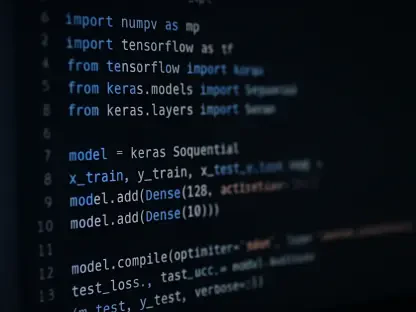Introduction to DOD’s Software Transformation
In an era where cyber warfare can determine the outcome of national security operations, the U.S. Department of Defense (DOD) faces an unprecedented challenge: delivering mission-critical software at the speed of battle while ensuring ironclad security. With adversaries leveraging advanced technologies to exploit vulnerabilities in real time, the DOD recognizes that outdated development practices could jeopardize operational success. This pressing reality has spurred a transformative shift toward rapid, secure software deployment as a cornerstone of defense strategy, prioritizing agility to match the pace of modern threats.
The adoption of DevSecOps—a methodology that integrates development, security, and operations—alongside reforms to the Authority to Operate (ATO) process, marks a pivotal change in how the department approaches software delivery. These initiatives aim to eliminate delays inherent in traditional compliance frameworks, ensuring that warfighters receive cutting-edge tools without compromising safety. Senior leaders, including acting CIOs and operational commanders, drive this evolution, supported by units like the Marine Corps Community Services (MCCS), all while navigating an increasingly complex landscape of cyber risks.
This transformation is not merely technical but strategic, reflecting the DOD’s commitment to maintaining a technological edge. As threats evolve, the department’s focus on speed and adaptability underscores a broader mission to safeguard national interests through innovation. Key stakeholders across various branches are aligning efforts to redefine software development, setting the stage for a deeper exploration of trends, challenges, and future prospects in this critical domain.
Current Trends and Innovations in DOD Software Development
Embracing DevSecOps and Agile Methodologies
The DOD has increasingly embraced DevSecOps as a foundational approach to software development, merging development, security, and operations into a seamless workflow. This methodology prioritizes collaboration across teams to deliver software faster while embedding security from the outset, a stark departure from siloed, sequential processes of the past. By fostering continuous integration and delivery, DevSecOps enables the department to respond swiftly to mission needs without sacrificing protection against cyber threats.
A notable example of this in action is Operation StormBreaker, an initiative by the Marine Corps Community Services. This certified DevSecOps pipeline facilitates rapid software updates, ensuring that tools align with real-time operational demands rather than lagging behind due to bureaucratic delays. Such efforts highlight how speed and agility can enhance security, countering the notion that thoroughness must come at the expense of timeliness in military contexts.
Emerging technologies and agile methodologies further bolster this adaptability, allowing teams to iterate quickly in mission-critical environments. The shift from rigid compliance to risk-informed models also plays a crucial role, empowering decision-makers to prioritize based on actual threats rather than static checklists. This dynamic approach ensures that software development keeps pace with the fluid nature of modern warfare, where delays can have significant consequences.
Impact of Continuous ATO (cATO) on Deployment Speed
Continuous ATO, often referred to as cATO, represents a groundbreaking reform in the DOD’s authorization processes, enabling real-time problem-solving and accelerated code delivery to operators. Unlike traditional ATO, which often caused bottlenecks through lengthy approval cycles, cATO supports ongoing assessments, ensuring that software can be deployed as soon as it meets security standards. This capability is vital for maintaining operational relevance in fast-moving scenarios.
Insights from the Air Force Research Laboratory underscore the impact of cATO, with deployment timelines shrinking from years to mere months. Such reductions allow teams to incorporate immediate feedback from the field, adapting solutions to address urgent priorities without prolonged waits. This iterative process not only enhances mission readiness but also ensures that software remains aligned with evolving requirements.
Looking ahead, cATO is poised to transform how the DOD manages operational pivots, with performance indicators already demonstrating measurable improvements in deployment efficiency. Metrics such as reduced time-to-field and increased update frequency reflect a tangible boost in the department’s ability to equip warfighters promptly. As this practice matures, its integration with agile workflows promises even greater strides in responsiveness and effectiveness.
Challenges in Modernizing DOD Software Practices
Transitioning from manual, document-intensive processes like the Risk Management Framework (RMF) to automated systems presents significant hurdles for the DOD. The RMF, while thorough, often delays critical deployments due to its reliance on extensive paperwork and sequential approvals, clashing with the need for speed in cyber operations. Automation offers a solution, but integrating it into entrenched workflows requires overcoming technical and procedural inertia.
Cultural resistance within the department adds another layer of complexity, as many personnel remain skeptical of automated pipelines due to a lack of trust in their reliability. Concerns also arise regarding innovations like agentic AI, with apprehension about delegating critical tasks to unproven technologies. This hesitancy can slow the adoption of tools that are essential for maintaining a competitive edge in digital warfare.
Moreover, there is a risk of automating flawed processes, which could amplify inefficiencies rather than resolve them. Readiness across all roles—from developers to leadership—is crucial to ensure that new systems are implemented effectively. Strategies such as comprehensive training programs and phased rollouts could help mitigate these challenges, building confidence in automation while addressing gaps in skills and understanding.
Regulatory and Compliance Reforms in DOD Software Processes
The traditional ATO process, designed to ensure security through rigorous vetting, struggles to keep pace with the dynamic nature of cyber threats facing the DOD. Lengthy authorization cycles often result in software becoming outdated before it even reaches the field, undermining mission objectives. This mismatch between compliance timelines and operational needs has prompted a reevaluation of existing frameworks.
Ongoing reforms aim to modernize these processes by adopting risk-informed approaches that prioritize real-time threat assessment over inflexible checklists. By focusing on actual vulnerabilities rather than predefined criteria, the department can authorize software more swiftly without compromising safety. This shift reflects a broader recognition that security must evolve alongside the tactics of adversaries.
Standardization and automation are also central to transforming compliance, enabling continuous monitoring through real-time security dashboards derived from development pipelines. These tools embed cybersecurity from the start, reducing the need for after-the-fact validations. Balancing robust protection with accelerated delivery remains a key focus, as regulatory updates strive to align with the urgency of modern defense requirements.
Future Outlook for DOD Software Development
The trajectory of the DOD’s software modernization points toward greater reliance on automation, data-centric security, and agile systems to meet future demands. As cyber threats become more sophisticated, the department is likely to deepen its investment in technologies that enable rapid response and predictive capabilities. This forward-looking approach aims to preempt challenges rather than merely react to them.
Potential disruptors, such as advancing adversarial tactics and emerging technologies, will continue to shape strategic priorities. The integration of advanced tools like machine learning for threat detection could redefine operational workflows, but it will require careful calibration to avoid over-reliance on untested systems. Staying ahead of these disruptions demands a proactive stance in both policy and practice.
Cultural change will be equally critical, as fostering trust in automated systems across the department can unlock their full potential. Growth areas, such as the expanded use of initiatives like Rapid Assess and Incorporate Software Engineering (RAISE) certification, offer promising avenues for scaling innovation. By embedding agility and collaboration into the core of software development, the DOD can position itself to navigate an increasingly complex digital battlefield.
Conclusion and Strategic Recommendations
Reflecting on the strides made, the DOD has demonstrated a resolute commitment to overhauling software development through DevSecOps and ATO reform. The emphasis on speed, agility, and real-time security posture addresses critical gaps in meeting modern threats, marking a significant evolution in defense capabilities. Leaders across various branches have championed these changes, recognizing software as a linchpin of operational success.
Moving forward, actionable steps should include sustained investment in training programs to ease the transition to automation, ensuring personnel at all levels are equipped to leverage new tools. Standardizing processes across units can further streamline efforts, reducing inconsistencies that slow progress. Exploring partnerships with industry experts could also accelerate the adoption of best practices tailored to military needs.
Ultimately, the path ahead calls for a continued focus on integrating emerging technologies while maintaining a balance with proven security measures. By fostering an environment of innovation and trust, the department can build on past achievements to deliver cutting-edge solutions. This strategic alignment promises to strengthen national defense in an era where digital prowess is as vital as physical might.









